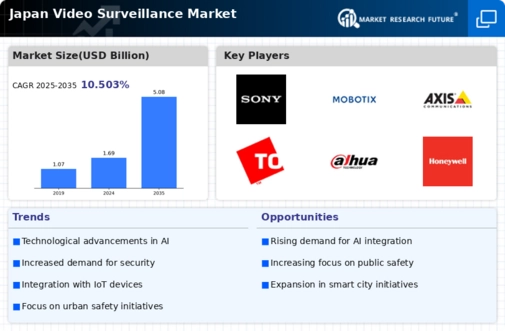The video surveillance market in Japan is characterized by a dynamic competitive landscape, driven by technological advancements and increasing demand for security solutions across various sectors. Key players such as Hikvision (CN), Axis Communications (SE), and Sony (JP) are at the forefront, each adopting distinct strategies to enhance their market presence. Hikvision (CN) focuses on innovation through the development of AI-powered surveillance systems, while Axis Communications (SE) emphasizes partnerships with local firms to expand its reach. Sony (JP), leveraging its expertise in imaging technology, aims to integrate advanced analytics into its offerings, thereby enhancing user experience and operational efficiency. Collectively, these strategies contribute to a competitive environment that is increasingly centered around technological differentiation and customer-centric solutions.
In terms of business tactics, companies are increasingly localizing manufacturing and optimizing supply chains to respond swiftly to market demands. The competitive structure of the market appears moderately fragmented, with several players vying for market share. However, the influence of major companies is substantial, as they set benchmarks for innovation and service quality, thereby shaping the overall market dynamics.
In October 2025, Hikvision (CN) announced the launch of a new line of AI-driven cameras designed specifically for urban environments. This strategic move is significant as it aligns with the growing trend of smart city initiatives in Japan, positioning Hikvision (CN) to capture a larger share of the urban surveillance market. The integration of AI capabilities not only enhances the functionality of their products but also addresses the increasing demand for intelligent surveillance solutions.
In September 2025, Axis Communications (SE) entered into a strategic partnership with a leading Japanese telecommunications provider to enhance its service offerings. This collaboration is pivotal as it allows Axis to leverage the telecommunications provider's extensive network infrastructure, facilitating the deployment of advanced surveillance solutions across urban areas. Such partnerships are indicative of a broader trend where companies seek to combine their strengths to deliver comprehensive security solutions.
In August 2025, Sony (JP) unveiled a new cloud-based video surveillance platform that integrates machine learning capabilities. This development is crucial as it reflects the industry's shift towards cloud solutions, enabling users to access and analyze video data remotely. By focusing on cloud technology, Sony (JP) positions itself as a leader in the digital transformation of surveillance, catering to the evolving needs of customers seeking flexibility and scalability in their security systems.
As of November 2025, the competitive trends in the video surveillance market are increasingly defined by digitalization, sustainability, and the integration of AI technologies. Strategic alliances are becoming more prevalent, as companies recognize the value of collaboration in enhancing their technological capabilities. Looking ahead, competitive differentiation is likely to evolve from traditional price-based competition to a focus on innovation, advanced technology, and reliable supply chains. This shift underscores the importance of adaptability and forward-thinking strategies in maintaining a competitive edge in the rapidly changing landscape.






















Leave a Comment